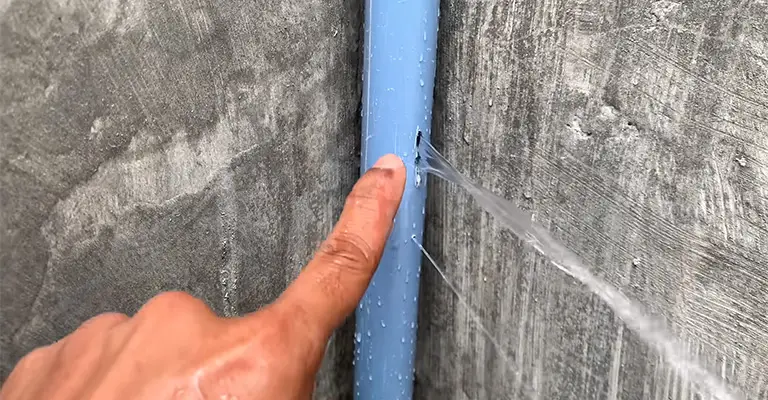A hole in a plastic water pipe can be a frustrating and potentially costly problem to deal with. Whether it’s a small pinhole leak or a larger breach in the pipe, it’s essential to address the issue promptly to prevent water damage and wastage.
Fortunately, repairing a hole in a plastic water pipe is a task that homeowners with some essential tools and materials can often accomplish.
It is known that polyvinyl chloride (PVC) pipes have durable and lightweight properties that make them a sustainable solution for sewage, plumbing, and irrigation systems.
A PVC pipe is most commonly identified by its white or cream color. It is typically connected using couplings and solvent cement, which melts the surface layer of the pipe and binds it together.
It has a high degree of ease of use and affordability, making it the most popular drain piping material.
Generally, PVC damage can be repaired with existing pipes to prevent leaks from getting worse. In some cases, the pipe may have to be replaced if the damage is too extensive.
Fortunately, you don’t have to buy a replacement pipe immediately. You can save a lot of money by merely following this guide on how to fix a hole in a plastic water pipe.
Common Reasons for PVC Leaks
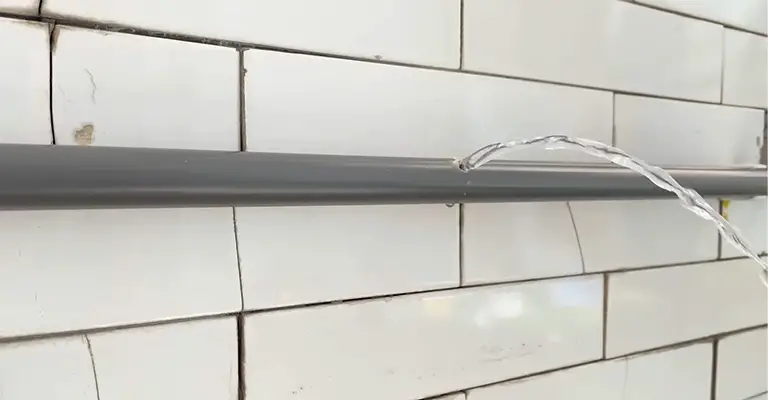
Some of the most common reasons for replacing or repairing PVC pipes include:
1. Freezing Temperatures
However, PVC can become brittle as well as damaged under extreme winter weather conditions, even if it is resistant to freezing.
Keep your pipes in good condition by insulating them if you live in an area that experiences cold temperatures.
2. Wrong Adhesive Glue
To prevent premature deterioration of PVC cement, ensure that it is bought at the right time.
Confirming the glue’s label specifies that it is designed to adhere to PVC before deciding which one to use is imperative. No matter which glue you select, it will eventually deteriorate with age and must be repaired.
3. Improper Installation
It can leak whenever a PVC fitting is not installed correctly onto the joining pipe. Usually, this happens when a fitting is loosely fitting, allowing water to leak through.
Tools Needed For Pipe Repair
In the paragraphs below, I’ll discuss some ways to fix damaged, unpressurized pipes. Material requirements will vary depending on the method you choose:
- Fiberglass resin cloth and UV light
- Fiberglass resin tape
- Epoxy putty
- Joiners, ratchet cutter, cobra clips or poly clips, and pliers
- Rubber and silicone tape
- Rubber tape and hose clamps
How To Patch A Leaking PVC Pipe
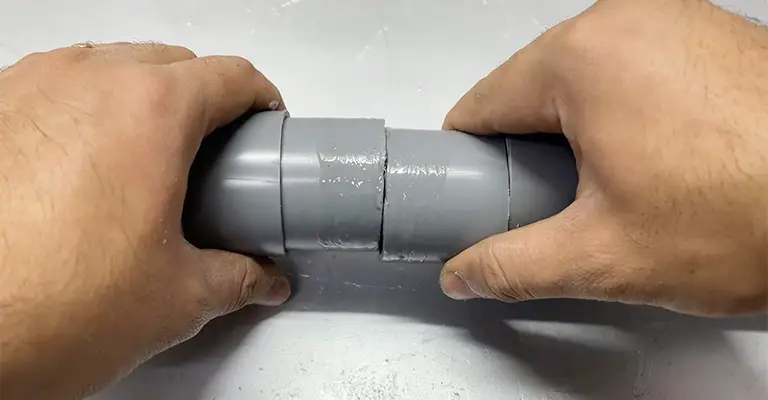
It is easy to glue plastic pipes to one another, especially if they are glued together correctly. In any case, it is not 100% leak-proof, as is the case with most plastics.
Various factors can lead to pipe damage, including:
- Using the wrong type of cement for PVC
- Installation of the pipe incorrectly
- Endangering the pipe via puncture or impact (for example, accidentally hammering a nail into it)
- Extreme cold
There are several quick-fix methods you can try if one of these causes a hole in an unpressurized plastic pipe:
1. Fiberglass Resin Cloth Method
While fiberglass tape can work, it’s more of a temporary fix. If you want something more permanent, go for fiberglass resin cloth.
As a result, it is resistant to temperature changes, which is helpful since extreme cold can lead to burst pipes. This is how a fiberglass cloth is used:
- Using a damp cloth, wipe the leaky area.
- Smooth the affected area to improve the fiberglass wrap stick.
- Carefully wrap the affected area in the cloth.
- Shine a UV lamp directly onto the resin to cure it.
Pro tip: Instead of a UV light, you can expose the patched pipe to sunlight to cure the resin cloth.
2. Fiberglass Tape Method
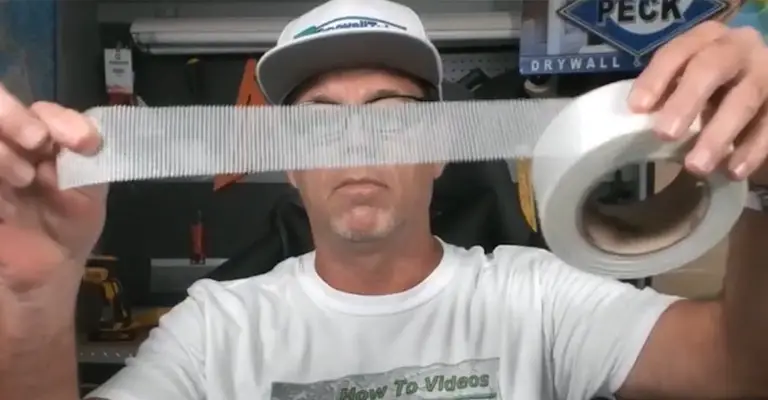
A fiberglass tape consists of a resin-activated resin that hardens around the pipe and seals the leak.
For this material to be helpful to you, you need to:
- Use a damp cloth to clean the damaged part of the pipe.
- Wrap the tape around small leaks while the pipe is still wet.
- After the resin hardens, remove the mold.
3. Epoxy Method
The epoxy you use to repair pipe cracks and joints is a viscous liquid putty. During the application of this material, you must:
- Thoroughly clean and dry the affected area.
- Follow the manufacturer’s instructions when mixing the epoxy putty. Simply cut the amount of putty you’ll need for sealing when using a putty stick.
- Using the epoxy, cover the damaged area. Ensure it has been cured for at least 10 minutes before using.
- Connect the water line an hour after the putty has been applied. If you check if all leaks have been sealed properly, you can be sure they have been.
Pro tip: Epoxy putty is great for tight spaces since mixing it with anything is unnecessary. You can merely slap it in the hole, and you are done. The tape does not need to be wrapped around like a rubber or silicone tape would.
4. Rubber And Silicone Repair Tape Method
It will be easy for you to plug the small holes in your existing pipe with rubber/silicone repair tape. The cracks can be sealed simply by reacting with it.
It’s a great method since there are no fancy tools needed. Additionally, the tape stretches 300% more than its average size.
In addition to rubber and silicone tapes, they are also able to withstand pressures of up to 30 bar. It is, therefore, useful when you cannot turn off the water supply to seal leaks in pipes.
Additionally, unlike sticky adhesives, you don’t have to worry about making a lot of mess with this tape.
Here are some tips on using rubber and silicone tape to fix your pipes:
- Ensure the tape is tightly wound around the hole. As well as covering the leak, cover the area around it.
- Tape does the magic. It will create a tight seal around the hole within mere seconds that keeps water and air out.
5. Rubber Tape And Hose Clamp Method
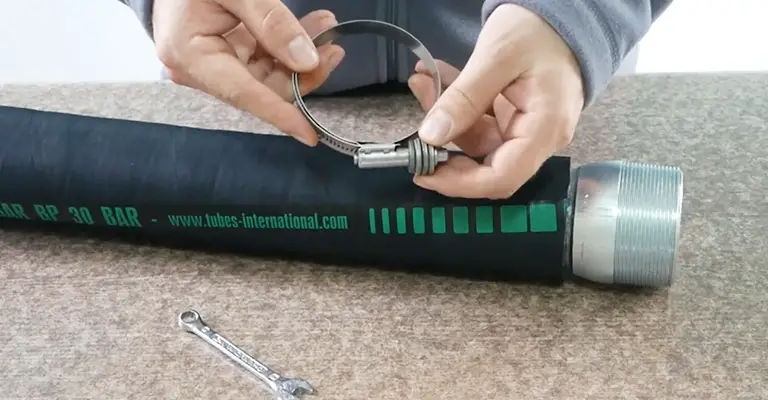
Using these materials helps compress the holes/leaks in the pipes so that they do not leak. It only requires two simple steps, which makes it one of the easiest methods listed here:
- Tape around the affected area with the rubber tape.
- Fix the holes/leaking areas with hose clamps. It is important to tighten them.
Pro tip: This fix is only temporary! If the leak has grown bigger, it will be harder for you to use rubber tape and hose clamp.
6. Joiner Method
It may be worth considering the joiner method if none of the above methods worked. Pipe connectors and fittings are used to connect the two undamaged ends of a pipe.
The following steps will help you install joiners:
- In case the damaged pipe has both sides, cut them both.
- Attach a poly clip or cobra clip to one of the pipes.
- Insert the joiner into the end of the pipe which has been cut.
- Connect the cut-out pipes with the other end of the connector
- Attach a cobra clip or poly clip at the joint where the pipe is cut and the joint is formed. You can either use pliers or your hand to secure them.
Pro tip: Be careful not to tighten the clip too much because it may break the pipe.
FAQs
1. When Should You Replace A Damaged PVC Pipe?
Two scenarios require you to replace a damaged area of the pipe:
- You can’t fix the leaky pipe unless it is pressurized (the quick fixes above have failed)
- Repairing the damaged area with the methods mentioned above isn’t possible
Even though replacing PVC pipes can seem challenging (especially in a tight space) is possible. You must first prepare the required materials:
- Hacksaw
- Replacement PVC pipe
- PVC primer
- Pipe glue/adhesive
It is time to replace the pipe once you have collected all the above equipment. You can do this by following these steps:
- Stop the water flow in the pipe. In the pipes, drain excess water.
- Remove the damaged/leaky section.
- Using the replacement PVC pipe, cut a part off. Check to see that it sits properly in the area it will occupy by dry fitting it.
- Prime the parts that will be attached with PVC primer.
- Spread liberally the adhesive onto the parts.
- Make sure the parts are attached immediately so the adhesive can work.
- Apply tension to the parts for 30 seconds or longer, depending on the manufacturer’s instructions.
- Remove any excess adhesive material with a cloth.
How Do You Prevent Plastic Pipe Leaks?
If your PVC pipes are repaired or replaced, that does not mean they won’t leak again in the near future. The following steps are necessary to prevent further or additional damage:
Install Electric Water Sensors
PVC pipes mounted in tight spaces may need to be replaced. Therefore, you may be unable to inspect them as often as possible.
Although this is true, installing electric water sensors in these areas might still prevent pipe leaks. A leak or moisture buildup will prompt them to turn off your water supply.
Insulate the Pipes
If you live in a cold climate, then your plastic pipes are at risk of damage. During freezing, water can freeze, and ice buildup will put undue strain on pipes.
As a result, the pipes burst.
So, before winter hits, ensure your pipes are insulated immediately. The following video shows you how to do it.
Inspect the Pipes Regularly
Touching the pipes can help you detect moisture immediately. Simply looking for signs of damage (i.e. discoloration of the pipes) doesn’t suffice.
In addition to inspecting all pipes around your home, these high-risk areas should receive special attention: the kitchen sink, dishwasher, bathroom sink, and washing machine.
As a result, loose or weak connections will also be found on the pipes. Keep them running so you won’t have to worry about them breaking down!
You should tighten the fittings with pliers and fix anything that needs to be repaired as soon as possible before they become damaged ultimately.
Final Words
You should only use these fixes on leaks with unpressurized plastic pipes. Replace damaged sections of pressurized pipes or larger holes immediately if they are damaged.

